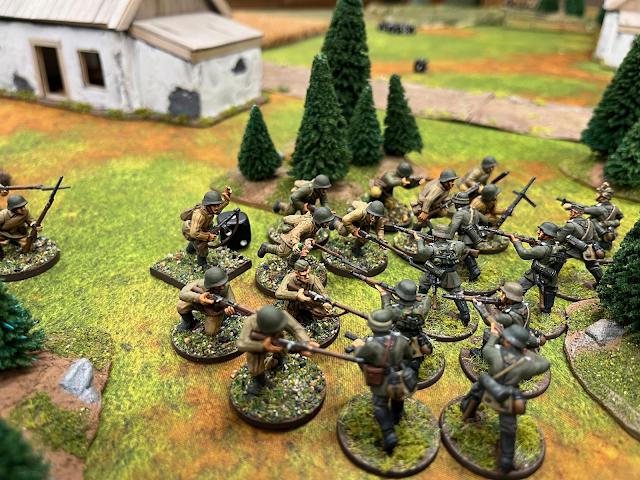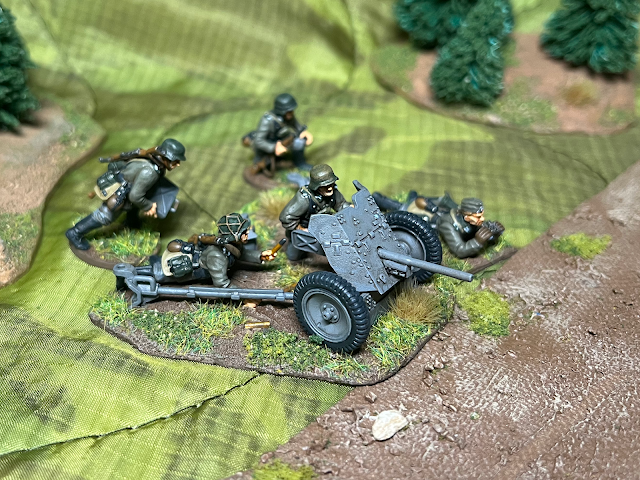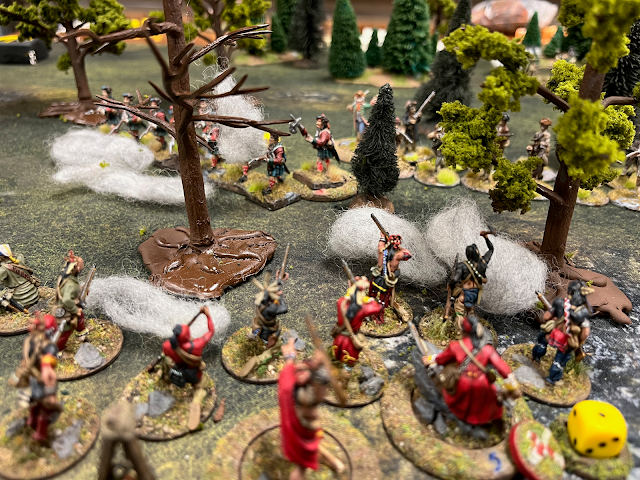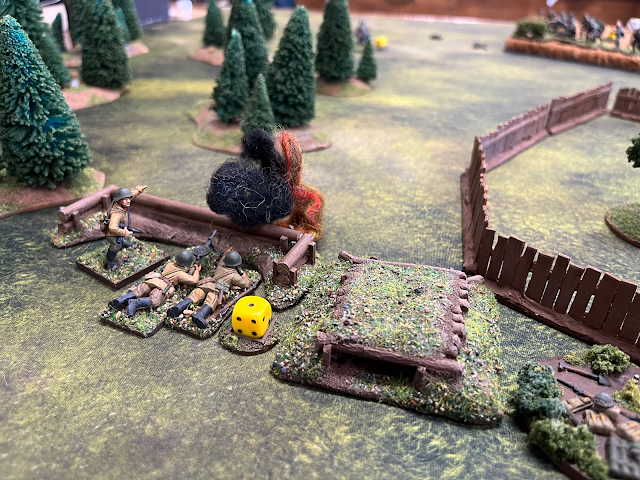I'd like to take a look at two games that were over remarkably quickly - almost before they began. This is the first of them.
For context, many of our Chain of Command games drag on for several hours, as a result of maneuvering, lots of shooting, plenty of chatting between turns, and of course the delays from me taking photos and notes for the blog. These big games are still enjoyable, but it's interesting to see a much shorter and sharper game.
My opponent, Alec, is relatively new to the game, with just a half dozen or so games under his belt. He was my opponent for this game, where his attack started alright but had trouble breaking through the few valiant Soviets.
For these two games, we went to Russia (perhaps the Ukraine or Belarus, really) in 1941 for a game that saw the Germans defending a small cluster of buildings on the outskirts of a Soviet village. I wanted to play Germans, as they are my main interest and I haven't gotten to in a bit. Alec chose to attack, wanting to work on his tactics, so this scenario represents a Soviet attempt at a localized counterattack during the early phases of Operation Barbarossa.
A view from the German table edge. The line of sight in this terrain is cut up by patches of forest and the two large
worker's dormitories. Even the
thatched izba is rather large, compared to some other huts and cabins in the steppe country.
The Soviets had 9 Force Morale, the Germans had 8. We chose to play Attack and Defend from the core rulebook.
We (mostly I) made some errors throughout that I will mention, but I think you will see that none of them affected the games. The first being that I rated the Soviet rifle platoon incorrectly. It was rated at +4 for these games, when I think it should have been +1, the same as the German force. Oops.
The patrol phase went like this, with the attacking Soviets getting a toehold on one of the worker's buildings while the Germans defended the yard of the izba and the forest. I think the third German Jump Off Point was over in the woods on the left of the photo.
Alec rolled up 9 support points for the Soviets, and with the (incorrect) force rating difference, the Germans had 7 points to spend. Alec began gleefully asking me if I had a KV-1 or KV-2, so I had some idea of what to expect.


With tanks unable to move through the forest, I selected two minefields that were placed on either flank to keep the tank funneled down the center, or at least pushed over to the far left side where I could potentially get a side shot with my other support - a 5cm PaK38 anti-tank gun.
The Soviets brought a KV-1 and a pre-game barrage, and I didn't have to wait long to see the tank, which came out in the very first phase, on overwatch looking down the road.
Along with it came the first squad of Soviet infantry, forced the deploy into the worker's housing because of the minefield and the size of the squad. My intent was not to block his infantry deployment with the minefield, as I find that to be unfair. This was a purely coincidental problem. He could still move past it, he just couldn't fit his whole squad outside the building within 6 inches of his JOP.
I take no action in my first phase, waiting for the Soviets to come to me. Alec has a lot of 5's and a 6 in his next command roll, so the attack pauses for a moment.


The Germans bring on a squad in the woods, back from the edge to remain out of sight of the Soviets. In our group, we have ruled that troops can only see 4 inches into a clump of forest, but that troops inside the forest have 6 inches of visibility. This avoids troops stumbling around the woods and finding themselves in close combat as soon as they see the foe.
Here, I may have made an error. I rolled for the effect of the barrage on my deployment, but forgot to factor in the Soviet's 'Wrath of the Gods' special rule. This is a bit unfair, as I remembered it in the next game, when I had the Soviets.
For the unaware, in CoC a pre-game barrage forces you to roll to see if your troops come on the table when you want, to represent the confusion and suppression caused by shelling. Usually you need a roll of 4 or more on 1d6, but the Soviet bombardment is more severe and requires a 5 or 6 to come through. I did not record the roll that got these guys on the table, so there's a 1 in 3 change that I made a mistake. However, I think you will see that this mistake had very little effect on the outcome of
either game.
Back to the action: the Soviets, eager to get to grips with the enemy, rush out of the building on the sprint, taking one shock and coming to the edge of the treeline, just out of sight of the Germans.
The Germans, no doubt hearing the rattle of equipment as their foe sprints across the open, lie in wait and go on overwatch, ready to give the Russians a warm reception if they intend to liberate this particular section of forest.
Elsewhere, a second German squad fails to make it through the barrage.
A second Soviet squad comes on, putting some pressure on the German right, though the threat feels less immediate than the other squad or the tank.
A third squad comes on in the worker's dormitory to eventually move up in support of the first squad. The Soviets are rightfully wary about the Germans on overwatch in the forest, and would like to tackle that fight with superior numbers, if they can.
In the German phase, attempts to reinforce the positions with another squad or even the light mortar team have no effect, with the barrage keeping the disorganized Germans from deploying.
Over the next couple phases, the two Soviet squads form up just outside the forest, culminating in an end of turn roll on the command dice that removes the German squad's overwatch. This isn't looking particularly good.
In the meantime, the Germans have tried and failed to get reinforcements on. Even with a double phase, they only managed to get a Senior Leader on before the Soviets lift the overwatch. His command initiative and submachine gun will be useful in the coming fight, but I doubt it will be enough.
With a second phase after the end of turn, the Soviets choose to make their attack. Now, they don't have a Senior Leader with them, so the two Junior Leaders will have to lead their squads in one at a time. This isn't ideal, but it's unlikely to matter much, either.
Bayonets are locked in place and the Soviet serzheant checks that his submachine gun is ready for action before he and his men rush headlong into the forest. For the motherland, and all that.
The Germans have one last chance - a Chain of Command die is spent, and they interrupt to fire at the onrushing Russians. The results are less than devastating, but not insignificant. We ruled that the Soviets, now in the forest, benefit from light cover, dampening the blow. But the one man hit is the Junior Leader, who loses a command initiative, and the squad takes a point of shock. Anything to rob them of dice in close combat.
Unfortunately, in the adrenaline of the charge, the Soviet leader's wound is overlooked, and the platoon's Force Morale is not affected.
A bitter hand-to-hand fight ensues, and the first Soviet squad proves to be a sacrificial lamb. They are assaulting a unit in cover, with a light machine gun, and with two SMG-toting leaders present.
In the end, it's 34 German dice versus 13 Soviet dice. Again, I unintentionally shorted Alec here. He should have had 14 dice.
The Germans inflict a sobering 17 kills and eight points of shock, easily enough to eradicate the 11-man Soviet squad. But the Soviets manage eight kills and two points of shock. In the melee, the German platoon sergeant is clubbed unconscious with a rifle butt, so he won't be able to pitch in when the other Soviet squad makes their charge.
Alec plays a Chain of Command die to ignore one Force Morale roll - smart - and the other Bad Things Happen roll only reduces Soviet FM by one point, to eight.
The Germans lose one point of FM for the SL's wound and another for the loss of the rifle team, bringing them down to six.
With their platoon sergeant stunned at their feet and the forest floor covered with dead and dying men, the German machine gunner hefts his weapon at the hip while his loader readies another belt of ammunition. The Junior Leader, still standing, loads a fresh magazine into his MP-40 and racks the bolt back.
The second Soviet squad comes rushing in, bayonets held at chest height. If they are more hesitant after watching their sister squad cut down to a man, they don't show it.
This time, the close combat dice are more even - 15 to 15 - and the outcome is fairly predictable. Five kills is enough to kill the Germans off, their leaders either slain or taken captive. The Germans take six men down with them though, and put on two points of shock so the Russians have something to remember them by.
Perhaps most vitally, the Soviet Junior Leader is knocked down and stunned for the duration of the turn. But the Soviet Force Morale only drops one point, to seven. Not enough to properly turn the tide.
The toll on the German platoon, which still has two-thirds of its strength off the table, is worse. The leaders killed or captured drops their Force Morale three points to three, just enough to stay in the fight. I can't even recall if I remembered to roll for team wiped out. I knew things were over, but I did have one last thing to try.
I wanted a shot at that tank!
I had planned to wait for the KV to turn and try for a side shot, but that had not been an option. Besides, at this point I was just doing this for grins.
The PaK38 fired off one shot, which hit - 7 AP versus 8 armor - and promptly bounced off the beast's thick armor plate.
At this point, I conceded, knowing that victory was not impossible, but definitely unlikely.
---
Alec definitely played this one well, even if his strategy was basically to go for broke. He could have done better by having a Senior Leader to order both squads into melee at one time, but at the end of the day the Soviet numbers won that fight anyway.
I had been trying to get another squad on, either in those woods or on the other flank, to pressure the Soviets and get attention off that squad in the woods, but the Soviet pre-game barrage prevented it.
This is even further evidence that close combat is the bloodiest type of fighting in Chain of Command. I feel like my German squad acquitted itself well, killing off a number of Soviets before going down.
In a few days, I'll post part two of this match-up, where we swapped sides - me taking the attacking Soviets, Alec the defending Germans.
That game, as you might guess, was just as short and brutal as this one, but for entirely a different reason!

























Nice write up - seems like a fun game and Soviets being ordered to charge suicidally seems appropriate somehow!
ReplyDeleteVery fitting! It just never seems to work this well for me when I try it...
DeleteGlad you enjoyed.